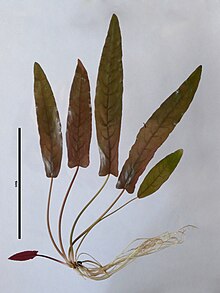Barclaya longifolia
| Barclaya longifolia | |
|---|---|
 | |
| Barclaya longifolia in its natural habitat Thailand with emergent chasmogamous flower | |
| Scientific classification | |
| Kingdom: | Plantae |
| Clade: | Tracheophytes |
| Clade: | Angiosperms |
| Order: | Nymphaeales |
| Family: | Nymphaeaceae |
| Genus: | Barclaya |
| Species: | B. longifolia |
| Binomial name | |
| Barclaya longifolia Wall.[2] | |
| Synonyms[2] | |
| |
Barclaya longifolia is a species of perennial aquatic plant native to the region of Indo-China to Northwest Peninsular Malaysia.[2]
Description
[edit]
Vegetative characteristics
[edit]Barclaya longifolia is a submerged, perennial, aquatic herb[3] with ovoid, tuberous, stoloniferous, 2-3 cm long, and 0.5-1.5 cm wide rhizomes.[4] The linear-lanceolate, 12-30 cm long and 2-5 cm wide leaves with an obtuse apex, and a cordate base have an undulate margin.[5] The abaxial leaf surface displays red colouration.[3] The petioles are 6-25 cm long.[6]
Generative characteristics
[edit]The submerged and cleistogamous, or emerged and chasmogamous,[7] 4-6 cm wide flowers are attached to 5-30 cm long peduncles with numerous trichomes.[4] The sepals are 1.5-2.5 cm long, and 0.5-0.6 cm wide.[6] The syncarpous, inferior gynoecium consists of 8-14 carpels.[8] The globose, reddish green to whitish, 1-2 cm wide fruit bears 1mm long, and 0.5 mm wide, echinate, brownish red, globose seeds[4] without an arillus.[6][8][9]
Cytology
[edit]The diploid chromosome count is 2n = 36.[4] The chloroplast genome is 158359 bp long.[10]
Reproduction
[edit]Vegetative reproduction
[edit]The rhizomes are stoloniferous.[4]
Generative reproduction
[edit]Barclaya longifolia can produce autogamous, submerged, cleistogamous flowers,[6][7][4][5] as well as emergent chasmogamous flowers.[7]
Taxonomy
[edit]Publication
[edit]It was first described by Nathaniel Wallich in 1827.[2] It is the type species of its genus.[6][4]
Type specimen
[edit]The type specimen was collected by Wallich in Rangoon, Myanmar in August 1826.[4][6]
Etymology
[edit]The specific epithet longifolia, from the Latin longus meaning "long", and folius meaning "leaf", means long-leaved.[11][12]
Conservation
[edit]The IUCN conservation status is least concern (LC).[1] It may be endangered in Peninsular Malaysia.[4] In India, it is a rare species.[13]
Ecology
[edit]Habitat
[edit]It occurs in quickly flowing rivers, streams, and stagnant pools. Disturbance of the substrate by wild boar may be beneficial for the establishment of Barclaya longifolia seedlings in their natural habitat.[4]
Use
[edit]In Laos, Barclaya longifolia is used for its edible leaves.[14]
Cultivation
[edit]It is a popular aquarium plant.[6][5][1] It can be easily cultivated in a mixture of pH-neutral, loamy and mineral soils[4] at temperatures of 26-29°C.[15]
References
[edit]- ^ a b c Juffe Bignoli, D. 2011. Barclaya longifolia. The IUCN Red List of Threatened Species 2011: e.T194024A8877322. https://dx.doi.org/10.2305/IUCN.UK.2011-1.RLTS.T194024A8877322.en. Accessed on 04 January 2024.
- ^ a b c d "Barclaya longifolia Wall". Plants of the World Online. Royal Botanic Gardens, Kew. Retrieved 4 January 2024.
- ^ a b Hughes, N. M., & Lev-Yadun, S. (2023). Why do some plants have leaves with red or purple undersides?. Environmental and Experimental Botany, 205, 105126.
- ^ a b c d e f g h i j k Jacobsen, N., Ganapathy, H., Ipor, I., Jensen, K. R., Komala, T., Mangsor, K. N., ... & Ørgaard, M. (2022). "A reassessment of the genus Barclaya (Nymphaeaceae) including three new species." Nordic Journal of Botany, 2022(5), e03392.
- ^ a b c Williamson, P.S., Schneider, E.L. (1994). Floral aspects of Barclaya (Nymphaeaceae): pollination, ontogeny and structure. In: Endress, P.K., Friis, E.M. (eds) Early Evolution of Flowers. Plant Systematics and Evolution Supplement 8, vol 8. Springer, Vienna. https://doi.org/10.1007/978-3-7091-6910-0_9
- ^ a b c d e f g La-ongsri, W., Trisonthi, C., & Balslev, H. (2009). "A synopsis of Thai Nymphaeaceae." Nordic Journal of Botany, 27(2), 97-114.
- ^ a b c Lok, A. F. S. L., Ang, W. F., Lee, S. M. L., Tan, H. H., & Tan, H. T. W. (2009). "The status and distribution of Barclaya (Nymphaeaceae) in Singapore." Nature in Singapore, 2, 237-245.
- ^ a b Schneider, E. L. (1978). Morphological Studies of the Nymphaeaceae. IX. The Seed of Barclaya longifolia Wall. Botanical Gazette, 139(2), 223–230. http://www.jstor.org/stable/2473739
- ^ "Botanische Jahrbücher für Systematik, Pflanzengeschichte und Pflanzengeographie." p. 224. (1894). Deutschland: Schweizerbart.
- ^ Zhang, H., Si, Y., Zhao, R., Sheng, Q., & Zhu, Z. (2023). Complete chloroplast genome and phylogenetic relationship of Nymphaea nouchali (Nymphaeaceae), a rare species of water lily in China. Gene, 858, 147139.
- ^ Erica longifolia. (n.d.). CasaBio. Retrieved January 4, 2024, from https://casabio.org/taxa/erica-longifolia
- ^ Irons, J. (n.d.). Understanding plant names. Retrieved January 4, 2024, from https://anpsa.org.au/APOL2007/may07-2.html
- ^ "Ecology and Management of Aquatic Vegetation in the Indian Subcontinent." p. 45. (2012). Deutschland: Springer Netherlands.
- ^ Vidal, J. (1964). Les Plantes utiles du Laos (suite). Journal d'agriculture traditionnelle et de botanique appliquée, 11(1), 18-50.
- ^ Schliewen, U. (2017). "Praxishandbuch Aquarium: Mit über 400 Fischarten, Amphibien und Wirbellosen im Porträt. Der Bestseller jetzt komplett neu überarbeitet." p. 103. Deutschland: GRÄFE UND UNZER Verlag GmbH.


 French
French Deutsch
Deutsch